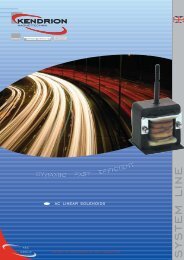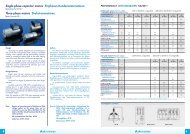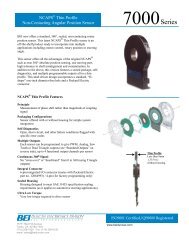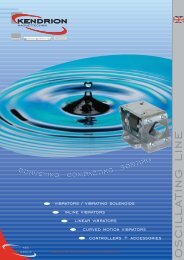Vibco Concrete Handbook.1 - Bertda Services
Vibco Concrete Handbook.1 - Bertda Services
Vibco Concrete Handbook.1 - Bertda Services
- No tags were found...
You also want an ePaper? Increase the reach of your titles
YUMPU automatically turns print PDFs into web optimized ePapers that Google loves.
GENERAL RULES FOR SELECTING, SIZING & PLACINGEXTERNAL VIBRATORS, cont’d.3. SIZING AND PLACING OF VIBRATORS (cont’d.)(C)BRACKETRY: The bracketry to be selected can be one of the standardbrackets shown on the preceding applications or you can design your ownin conjunction with VIBCO’s application engineers.4. VIBRATION PROCEDURE AND VIBRATION TIME(A)(B)VIBRATION PROCEDURE: Place vibrators to be used in their lowestposition. It’s a good idea to pre-mark the vibrator positions using a paintspray can. Do not start vibrators until the concrete reaches them or isabout 6”above them.TIP: If internal vibrators are used, do not start the external ones until theinternals have stopped or moved to a higher position. The reason is,internal vibrators throw air bubbles away from the vibrator head againstform side leaving air holes and pockets on surface. External vibrators throwair bubbles into the mix, up and out, leaving surface against form smoothand blemish free.HOW LONG TO VIBRATE: The time you need to vibrate varies dependingon concrete slump, additives, stiffness of form, vibrator force, etc.To determine the vibration time needed, it is advisable to make a test run;for example: On a column, take the time from the start of the vibrators towhen the concrete reaches the 1/2 way mark to the next higher row, look atthe concrete surface (use a flashlight if column is high). When no moreair bubbles are breaking on the surface, and a glistening surface appears ontop of the concrete, you have vibrated enough. The time this took is yourvibration time for the vibrators in each position for all the columns of that size.If you do not want to measure the time, you will have to watch the concretesurface for bubbles breaking and the glistening slick surface each time,before moving the vibrators.NOTE: If the walls or columns are too high to determine the vibration timeby observing air bubbles breaking on the surface – the contractors on page8 and 13 elected to run the vibrators until the concrete reached the next higherrow. The lower vibrators were then stopped, moved up and restarted. “Overvibration”was a concern, but the tight rebars and the weight of the vibratedconcrete prevented any segregation. It was the opinion that the concrete cameout more homogenous with a better finish and strength. Caution should betaken if the concrete mix has a high slump with large aggregates.TIP: “Over-vibration” is something every contractor is afraid of (when theaggregate and sand separate and all the aggregate ends up in lumps or at thebottom of the form). The concern is well founded, but it takes a long vibrationtime and a lot of vibration force to reach this point. Our experience has beento see “under-vibration” rather than “over-vibration,” too little vibration timeor force to get a homogenous mix free of air bubbles.181-800-633-0032
















